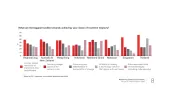
Withstanding the regulatory wave of change
By Christian RahnschEveryone working within financial services agrees that the number and frequency of new regulations is increasing dramatically, resulting in a significant diversion of management attention and resources without improving operational effectiveness or firm performance.
Given the operational complexity and legacy technology issues of most financial services firms, it is not very surprising that most, if not all organisations struggle to get control on managing regulatory changes efficiently. The only thing certain for organisations is that uncertainty imposed by the continuously evolving regulatory environment will be a prevailing element of the industry. This challenges organisations in their ambitions to execute a consistent governance, risk and compliance strategy in a cost effective way.
Many of the clients we talk to are experiencing the same pain and are looking for better ways to efficiently manage regulatory changes and incorporate it into their daily ways of working. Some of the common pain points shared by our clients are:
• Constant fire fighting – can’t focus on the "day job" and achieve goals
• Delivers non-value adding, brain-numbing work for staff
• Diverts senior management time from strategic valuable work
• Reduces ability to coach and develop a more effective team
• Limited scope to play technology & innovation leadership role
• Increases cost to serve / operate
The key is to establish and implement a framework that enables you to determine the impact of new regulations quickly and then cascade the new process down to all aspects of operation, simultaneously addressing technology, people and process changes. Building upon key business process management principles, a simple four step approach can be executed to manage this process:
1. Identify Touch Points
A well-defined process architecture allows you to quickly identify processes, activities, roles, controls, templates, data etc., that are impacted by a new regulation.
2. Assess Impact of New Regulation
Keeping all relevant process related information in a single repository empowers the organisation to assess the scale and scope of the change impact. This can vary from simply updating the terms and conditions of a standard form to a major system upgrade.
3. Design & Implement Change
An integrated and process driven approach enables the organisation to efficiently design and roll out the new processes while ensuring that all relevant documentation is updated at the same time.
4. Monitor & Control Compliance
The process to comply with the new regulation and to govern the change can be easily incorporated into the process architecture including adequate monitor and control mechanism
This system only becomes efficient when the relevant information is held in a central repository. This "single source of truth" connects people, processes, and technology including all relevant artefacts like systems, roles, documents, risks, etc. It inevitably becomes the central Operating Model repository.
Acknowledging the fact that regulatory changes will be a constant challenge, organisations are well advised to start this journey and harvest the benefits associated with a holistic business process management approach.
Christian Rahnsch, Executive Consultant, Litmus Group



















 Advertise
Advertise










